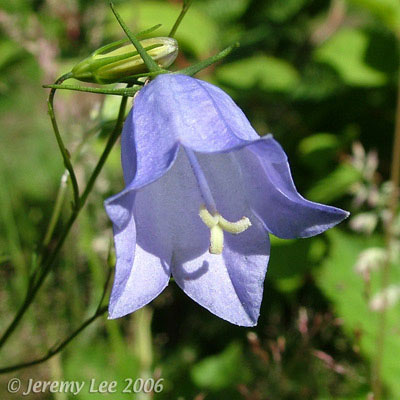
 |
|
Scientific Classifications explained » Amphibians » Ants » Aphids » Bees » Beetles » Birds » Bugs » Butterflies » Caterpillars » Damselflies » Dragonflies » Earwigs » Flies » Frog/Leafhoppers » Fungi » Galls » Grasshoppers » Harvestmen » Hoverflies » Lacewings » Ladybirds » Leaf Mines » Lichens » Mammals » Millipedes » Mosses » Moths » Sawflies » Slugs » Snails » Spiders » Trees & Shrubs » Wasps » Wild Flowers » Woodlice » Postboxes |
UK Nature > Wild Flowers > Blue & Purple Wild Flowers > Campanula rotundifolia

Scientific Name: Campanula rotundifolia Common Name: Harebell The delicate, nodding blue bells of Campanula rotundifolia are one of the prettiest additions to our hedgerows, grasslands, hillsides, sand dunes and cliffs. More commonly known as Harebell, they flower between July and September. Harebells grow on dry, mostly undisturbed, ground, but are tolerant of all kinds of habitats. It is regularly visited by bumblebees and honey bees (Apis mellifera), providing an autumnal source of nectar for these insects. A creeping perennial, the Harebell has long, trailing stems with small, club-shaped leaves at the base. Its stem leaves are much more elongated, and its blue, bell-shaped flowers hang in clusters at the tips of the stems. Very common throughout the UK mainland, but less so in Northern Ireland. |
|

https://www.uknature.co.uk is a website dedicated to showing the immense diversity of UK nature and wildlife. Our vast range of habitats, from lowland arable to snow covered mountains, from storm-ravaged coastlines to peaceful inland freshwater lakes and rivers, from dry, sandy heaths to deciduous and coniferous forests, all these habitats contribute to the abundance of UK nature. We have wild birds in huge numbers either residing or visiting our shores (597 recorded species as at July 2013) and we must also not forget the humble back garden with its grass lawns, flower beds filled with nectar rich flowers, shrubs and trees, all designed to attract huge numbers of insects such as bees, moths, butterflies and hoverflies; and finally the small ponds which provide safe havens for frogs, toads, newts and even slow worms and grass snakes. www.uknature.co.uk is the showcase for my personal passion, photographing uknature in all its glory. I sincerely hope you all enjoy the fruits of my labours. This site and all images contained therein is © Jeremy Lee 2004 - 2025. All Rights Reserved. Site design by Jeremy Lee. Site development & IT Support by Stuart Lee. |